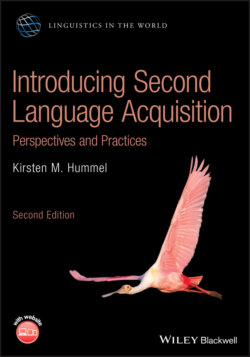Читать книгу Introducing Second Language Acquisition - Kirsten M. Hummel - Страница 11
Preface
ОглавлениеThis second edition of Introducing Second Language Acquisition: Perspectives and Practices has been undertaken in order to update and expand on topics presented in the first edition. Research in the field of second language acquisition (SLA) is growing at an exponential pace and regular updating of what we know about aspects of SLA is warranted.
While the basic structure of this edition conforms to that of the first edition, one major difference in response to reviewer suggestions is the division of the previously quite large chapter on Theoretical Perspectives into two separate chapters: “Theoretical Perspectives: Past and Present” and “Theoretical Perspectives: Cognitive Approaches.” This division should allow for a better pacing of presentation of this theoretical content.
In addition, to a considerable extent, each original chapter has been updated to reflect current research and practices. An example of considerable chapter expansion is that of Chapter 7, “Second Language Development,” which now includes separate subsections on “reading” and “writing” within the section on “The Development of Literacy‐Based Skills.” Another example is Chapter 10, “Bilingualism,” which is now titled “Bilingualism and Multilingualism” to reflect the ongoing considerable research attention drawn to situations of language acquisition and use of three or more languages.
An added feature at the beginning of each chapter is the presentation of concise “‘Learning objectives.” Also, additional “Language learning in practice” textboxes have been created or expanded throughout the book to allow more concrete examples of aspects of language learning. Illustrative tables have been added in some chapters. Furthermore, the supplemental material at the end of each chapter has been updated, with the addition of self‐assessment questions, and updating and additions to the further reading and viewing suggestions. The rapid increase in web resources allows substantial updating of viewing material in particular. The fictional characters and their trajectories remain in the text as examples of language learners in various language learning contexts. The book continues to highlight occasional cartoons to add artistry and humor to the text.
Despite efforts to update content, due to the rapid ongoing expansion of research in the field, along with space limitations, inevitably some recent findings may not have found their way into the book. Similarly, space restrictions limit the extent to which a number of issues could be examined at length; I hope the further reading and viewing recommendations go some way toward allowing a more in‐depth understanding of those issues.
